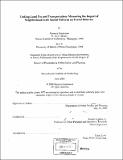| dc.contributor.advisor | Joseph Ferreira, Jr. | en_US |
| dc.contributor.author | Srinivasan, Sumeeta, 1968- | en_US |
| dc.contributor.other | Massachusetts Institute of Technology. Dept. of Urban Studies and Planning. | en_US |
| dc.date.accessioned | 2012-04-26T18:41:04Z | |
| dc.date.available | 2012-04-26T18:41:04Z | |
| dc.date.copyright | 2000 | en_US |
| dc.date.issued | 2000 | en_US |
| dc.identifier.uri | http://hdl.handle.net/1721.1/70335 | |
| dc.description | Thesis (Ph.D.)--Massachusetts Institute of Technology, Dept. of Urban Studies and Planning, 2000. | en_US |
| dc.description | Includes bibliographical references (leaves 224-235). | en_US |
| dc.description.abstract | This dissertation aims to understand how changes in land use and transportation regulations at a local level could affect travel behavior such as trip-linking and mode choice. Studies indicate that the geographic distribution of jobs and population is far more crucial than population growth alone in creating dramatic changes in travel in individual locations. Land use initiatives represent a potentially effective tool for coping with the kinds of mobility patterns that North American cities face in the 1990s and in the coming century. As fine-grained data about land use and travel activity becomes available, it provides the opportunity to improve our understanding of the linkage between land use and transportation. Thus, we can now add a land use element to the models that have been used in the past in order to investigate travel behavior. We, therefore can extend, not only our knowledge of the land use/ transportation connection, but also the tools that have been used in the past to study their linkage. This study examines in detail the neighborhood characteristics that affect travel behavior. Neighborhood characteristics include land use, network and accessibility related characteristics which are quantified through the use of Geographical Information Systems (GIS). Ultimately, such measures could be used in conjunction with detailed surveys of travel behavior to specify, calibrate and use models of modal choice and trip type that are more sensitive to the fine-grain spatial structure of neighborhoods and transportation corridors in our metropolitan areas. Micro-level data for the Boston metro area, together with a 1991 activity survey of approximately 10,000 residents provide a rich empirical basis for experimenting with relevant neighborhood measures and for simulating the effects on travel behavior. | en_US |
| dc.description.statementofresponsibility | by Sumeeta Srinivasan. | en_US |
| dc.format.extent | 245 leaves | en_US |
| dc.language.iso | eng | en_US |
| dc.publisher | Massachusetts Institute of Technology | en_US |
| dc.rights | M.I.T. theses are protected by
copyright. They may be viewed from this source for any purpose, but
reproduction or distribution in any format is prohibited without written
permission. See provided URL for inquiries about permission. | en_US |
| dc.rights.uri | http://dspace.mit.edu/handle/1721.1/7582 | en_US |
| dc.subject | Urban Studies and Planning. | en_US |
| dc.title | Linking land use and transportation : measuring the impact of neighborhood-scale spatial patterns on travel behavior | en_US |
| dc.type | Thesis | en_US |
| dc.description.degree | Ph.D. | en_US |
| dc.contributor.department | Massachusetts Institute of Technology. Department of Urban Studies and Planning | |
| dc.identifier.oclc | 47917809 | en_US |
